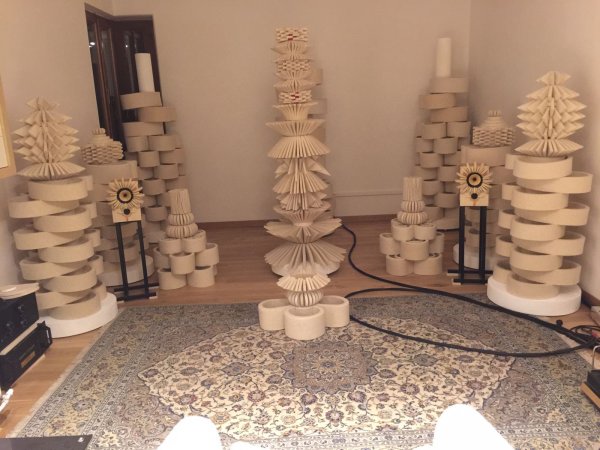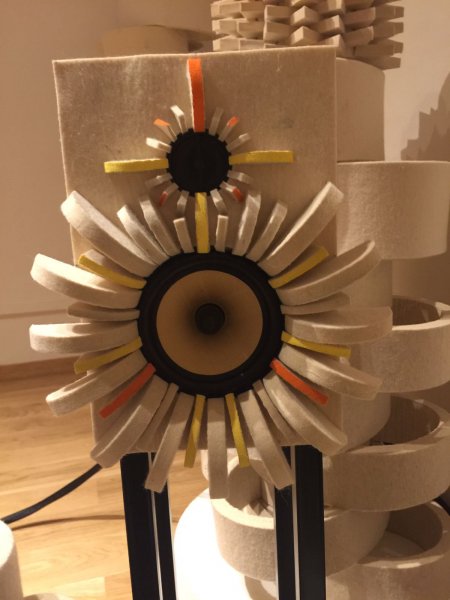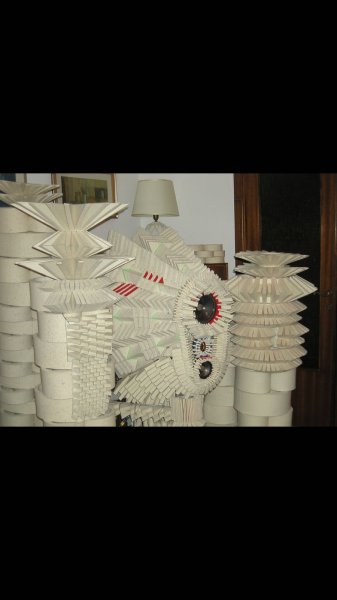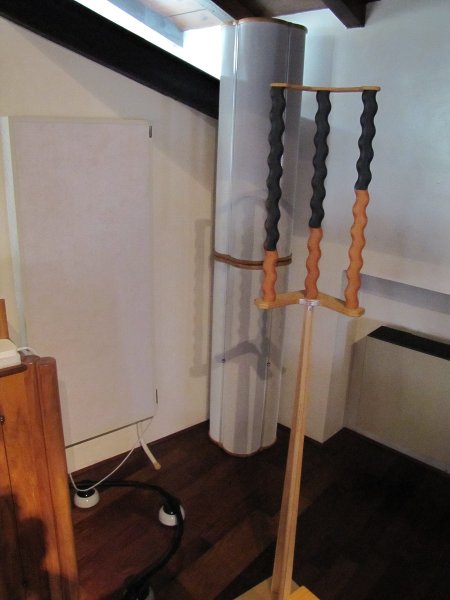Sonex and ASC Tube Traps are perhaps the best-known acoustical treatments. But the successful recalibration of most listening rooms will require more diffusion than broad-range absorption (Sonex) or low-frequency corner attenuation (Tube Traps). Before spending dime one, it’s imperative that you understand just what you’re trying to accomplish. The goal of room makeovers is generally to remove the room’s characteristic small acoustic “fingerprint” and replace it with the space, warmth, envelopment, and liveness of a very good concert hall.
These—the removal of one “layer” and the installation of another—are two separate tasks. Broad-range absorbers like Sonex’s sculpted open-cell foam can remove the cues that cry “small” by killing the early reflections from nearby surfaces that tip off the ear-brain as to the real size of the room. The best locations of these absorbers are typically arrived at by placing a mirror on the front and side walls and moving it until, from the listening position, one or both speakers are visible. At these points, attach Sonex, Owens-Corning, Armstrong SoundSoak, or similar acoustical products.
The second task, the setting up of a soundfield that cries “big,” requires diffusion, especially in the areas flanking and directly behind the listening position. The ideal diffusor takes broad-range acoustical energy and scatters it in a non-frequency and non-temporally related way throughout the room, regardless of the angle at which the energy initially impinges on it.
By eliminating hard “specular” reflections and flooding the listening environment with ambient energy, the diffusor fosters the smooth, logarithmically decaying reverberation that marks the best concert halls. Poor concert halls and most all domestic listening rooms have erratic energy/time curves as a result of inadequate diffusion and/or unfavorable ratios of room dimensions. Ideally, reverberation will ramp down to -60dB in approximately 500ms (RT60=0.5s).
There is an audiophile wrinkle to this classical prescription. Many, perhaps most, audiophiles own or at least hanker for speakers that happen to have polar patterns that assume a reflective, not absorptive, area behind and around them. Most planars—e.g., those from Quad, Magnepan, Apogee, Martin-Logan, Eminent Technology, Acoustat, Sound Lab, Infinity IRS, and old-timers like the KLH 9s and the Dayton-Wright XG series—are configured as dipoles, meaning they direct as much energy backward as they do forward. Many others, like the Ohm Walsh units, Bose 901s, dbx Soundfield series, ESS/Heil air motion transformers, and dozens of others similarly not on the current “best-dressed” list, also rely heavily on broad polar shaping to achieve their characteristic sounds.
By installing too much absorption in the areas around planars and these latter devices, you disrupt their intended tonal and spatial properties, as the foldback of the rear and side waves figures prominently in establishing the speaker’s “musicality.” For these reasons, it is often desirable either to replace the absorbers with diffusors (which are, after all, a special kind of reflector) behind and around the speakers, or to mix diffusors with broad-range absorbers. Consider experimenting with absorption by constructing an absorbent “muffler” to go around the back side of the speaker, varying its distance (or angling it) to allow more or less rear-radiated sound into the room. (If you’re not a do-it-yourselfer, look into a set of Watkins “Echo Muffs.”)




















